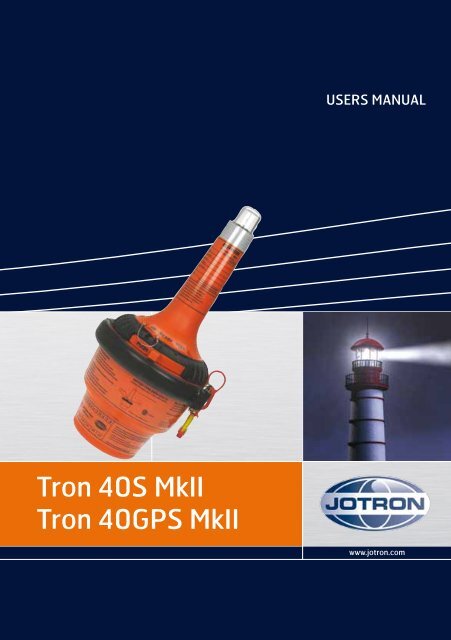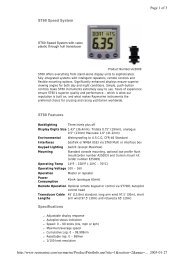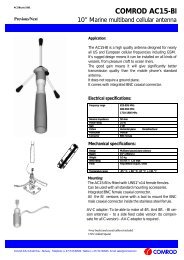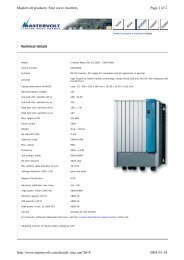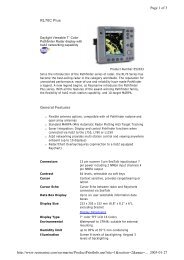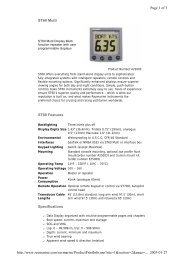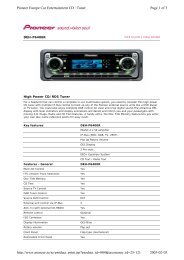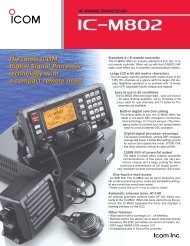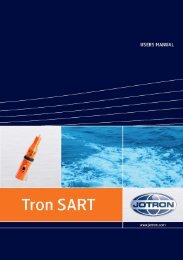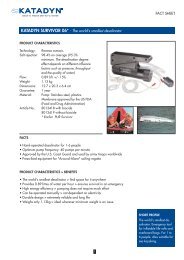TRON40GPS - Regina
TRON40GPS - Regina
TRON40GPS - Regina
Create successful ePaper yourself
Turn your PDF publications into a flip-book with our unique Google optimized e-Paper software.
USERS MANUAL<br />
Tron 40S MkII<br />
Tron 40GPS MkII<br />
www.jotron.com
www.jotron.com<br />
Amendment Records<br />
Amendment<br />
By Date Page(s) Vers. Reason for change<br />
no<br />
1 ES 05.07.07 Total 36 A New Manual<br />
2 ES 12.04.07 Total 36 B New company name<br />
3 ES 31.08.07 27 C Error message<br />
4 ES 31.01.08 21 and 22 D Man operation<br />
5 ES 10.03.08 2-6, 25, 30 E Added text<br />
6 ES 29.04.08 6-24 F Corrected text<br />
7 TH 30.01.09 Total 36 G Layout changes<br />
8 ES 06.01.10 17, 24-25,<br />
27, 32, 38, 41<br />
H<br />
New FB6 bracket<br />
Included GPS info<br />
9 FIT 25.08.10 Total 42 I Corrected text<br />
10 FIT 12.07.11 Total 36 J Added text<br />
2<br />
82819_UM_40SMkII_J
www.jotron.com<br />
Manual/Operation/Activation<br />
82819_UM_40SMkII_J<br />
3
www.jotron.com<br />
EC Declaration of Conformity, available at www.jotron.com<br />
Abbreviations and definitions<br />
BAUD<br />
Transmission rate unit of measurement for binary coded data (bit per second)<br />
BIT<br />
Short form of Binary Digit. The smallest element of data in a binary-coded value<br />
BPS<br />
Bits Per Second<br />
COSPAS<br />
COsmicheskaya Sistyema Poiska Avariynich Sudov (Space System for the<br />
Search of Vessels in Distress)<br />
EPIRB<br />
Emergency Position Indicating Radio Beacon<br />
GLOBAL POSITIONING SYSTEM (GPS)<br />
The NAVSTAR Global Positioning System, which consists of orbiting satellites, a<br />
network of ground control stations, and user positioning and navigation equipment.<br />
The system has 24 satellites plus 3 active spare satellites in six orbital<br />
planes about 20,200 kilometers above the earth.<br />
IEC<br />
International Electro-technical Commission<br />
IMO<br />
International Maritime Organization<br />
IBRD<br />
International 406MHz Beacon Registration Database<br />
ITU<br />
International Telecommunication Union<br />
4<br />
82819_UM_40SMkII_J
www.jotron.com<br />
LED<br />
Light Emitting Diode<br />
LUT<br />
Local User Terminal (Ground Station)<br />
MCA<br />
Marine and Coastguard Agency (UK)<br />
MCC<br />
Mission Control Centre<br />
NOAA<br />
National Oceanic and Atmospheric Administration (USA)<br />
RCC<br />
Rescue Coordination Centre<br />
SARSAT<br />
Search and Rescue Satellite-Aided Tracking System<br />
SBM<br />
Shore Based Maintenance – as required by SOLAS regulation IV/15.9.2 of<br />
SOLAS 1974 as amended with, in accordance with MSC/Circ. 1039 guidelines for<br />
Shore-Based Maintenance (SBM) of Satellite EPIRBs within 5 years if:<br />
Passenger ships (> 12 passengers) and cargo ships (> 300GT) engaged in International<br />
voyages, shall perform SBM as follows:<br />
• Latest by the date of the EPIRB label with this text, or the battery. Label,<br />
whichever is first<br />
• When this EPIRB becomes due for SBM in accordance with national requirements.<br />
82819_UM_40SMkII_J<br />
5
www.jotron.com<br />
BATTERY SAFETY DATA SHEET<br />
PRODUCT NAME:<br />
TYPE NO.:<br />
CELL WEIGHT:<br />
CHEMICAL SYSTEM:<br />
DESIGNED FOR RECHARGE:<br />
LITHIUM METAL CONTENT<br />
SAFT BATTERIES<br />
LSH14 LIGHT<br />
51 g<br />
Lithium/Thionyl chloride<br />
No<br />
Below 1 g/cell<br />
HAZARDS IDENTIFICATION<br />
Do not short circuit, recharge, puncture, incinerate, crush, immerse, force discharge<br />
or expose to<br />
temperatures above the declared operating temperature range of the product.<br />
Risk of fire or explosion. The Lithium-Thionyl chloride batteries described in<br />
this Safety Data Sheet are sealed units which are not hazardous when used according<br />
to the recommendations of the manufacturer.<br />
Under normal conditions of use, the electrode materials and liquid electrolyte<br />
they contain are not exposed tothe outside, provided the battery integrity is<br />
maintained and seals remain intact. Risk of exposure only in caseof abuse (mechanical,<br />
thermal, electrical) which leads to the activation of safety valves and/<br />
or the rupture ofthe battery container. Electrolyte leakage, electrode materials<br />
reaction with moisture/water or battery vent/explosion/fire may follow, depending<br />
upon the circumstances.<br />
COMPOSITION & INFORMATION ON INGREDIENTS<br />
Each cell consists of a hermetically sealed metallic container containing a<br />
number of chemicals and materials of construction of which the following could<br />
potentially be hazardous upon release.<br />
- Lithium content - 3.5-5%<br />
FIRST AID MEASURES<br />
Emergency contact: For chemical emergency ONLY (spill, leak, fire, exposure or<br />
accident),<br />
call CHEMTREC at: International: +1-703-527-3887. Within the USA: 1-800-<br />
424-9300<br />
6<br />
82819_UM_40SMkII_J
www.jotron.com<br />
Inhalation: Remove from exposure, rest and keep warm. In severe cases obtain<br />
medical attention.<br />
Skin contact: Wash off skin thoroughly with water. Remove contaminated clothing<br />
and wash<br />
before re-use. In severe cases obtain medical attention.<br />
Eye contact: Irrigate thoroughly with water for at least 15 minutes. Obtain medical<br />
attention.<br />
Ingestion: Wash out mouth thoroughly with water and give plenty of water to<br />
drink. Obtain medical attention.<br />
Further treatment: All cases of eye contamination, persistent skin irritation and<br />
casualties who<br />
have swallowed this substance or been affected by breathing its vapours<br />
should be seen by a Doctor.<br />
FIRE FIGHTING MEASURES<br />
CO2 extinguishers or, even preferably, copious quantities of water or waterbased<br />
foam, can be used to cool down burning Li- SOCl2 cells and batteries, as<br />
long as the extent of the fire has not progressed to the point that the lithium<br />
metal they contain is exposed (marked by deep red flames). Do not use for this<br />
purpose sand, dry powder or soda ash, graphite powder or fire blankets. Use<br />
only metal (Class D) extinguishers on raw lithium.<br />
Extinguishing media<br />
• Use water or C02 on burning Li-SOCI2 cells or batteries and class D fire extinguishing<br />
agent only on raw lithium.<br />
ACCIDENTAL RELEASE MEASURES<br />
Remove personnel from area until fumes dissipate. Do not breathe vapours or<br />
touch liquid with bare hands. If the skin has come into contact with the electrolyte,<br />
it should be washed thoroughly with water. Sand or earth should be used to<br />
absorb any exuded material. Seal leaking battery and contaminated absorbent<br />
material in plastic bag and dispose of as Special Waste in accordance with local<br />
regulations.<br />
HANDLING AND STORAGE<br />
Handling - Do not crush, pierce, short (+) and (-) battery terminals with conductive<br />
(i.e. metal) goods. Do not directly heat or solder. Do not throw into fire. Do<br />
not mix batteries of different types and brands. Do not mix new and used batteries.<br />
Keep batteries in non conductive (i.e. plastic) trays.<br />
Storage - Store in a cool (preferably below 30°C) and ventilated area, away<br />
82819_UM_40SMkII_J<br />
7
www.jotron.com<br />
from moisture, sources of heat, open flames, food and drink. Keep adequate<br />
clearance between walls and batteries.<br />
Temperature above 100°C may result in battery leakage and rupture. Since<br />
short circuit can cause burns, leakage and rupture hazard, keep batteries in<br />
original packaging until use and do not jumble them.<br />
Other - Lithium-Thionyl chloride batteries are not rechargeable and should<br />
not be tentatively charged. Follow Manufacturers recommendations regarding<br />
maximum recommended currents and operating temperature range. Applying<br />
pressure on deforming the battery may lead to disassembly followed by eye,<br />
skin and throat irritation.<br />
EXPOSURE CONTROLS & PERSONAL PROTECTION<br />
Respiratory protection - In all fire situations, use self-contained breathing apparatus<br />
Hand protection - In the event of leakage wear gloves<br />
Eye protection - Safety glasses are recommended during handling<br />
Other - In the event of leakage, wear chemical apron<br />
PHYSICAL AND CHEMICAL PROPERTIES<br />
Appearance - Cylindrical<br />
Odour - If leaking, gives off a pungent corrosive odour<br />
SEE MORE INFO ON MSDS/TRANSPORT DOCUMENTS ON WWW.JOTRON.COM<br />
Test and maintenance record<br />
DATE N/T/B SIGN INSP<br />
N= New EPIRB installed, T= Test, B= New battery<br />
8<br />
82819_UM_40SMkII_J
www.jotron.com<br />
IMPORTANT<br />
TO PERMANENTLY DISABLE EPIRB<br />
The battery module must be<br />
disconnected from the main module<br />
The information in this book has been carefully checked and is believed to be<br />
accurate. However, no responsibility is assumed for inaccuracies.<br />
CAUTION!<br />
This equipment contains CMOS integrated circuits. Observe handling precautions<br />
to avoid static discharges which may damage these devices. Jotron AS<br />
reserves the right to make changes without further notice to any products or<br />
modules described herein to improve reliability, function or design. Jotron AS<br />
does not assume any liability arising out of the application or use of the described<br />
product.<br />
WARNING / IMPORTANT<br />
Jotron AS is a prime manufacturer of safety equipment designed for rescue of<br />
human lives and their property. For safety equipment to be effective in line with<br />
the design parameters it is important that they are handled, stowed and maintained<br />
in compliance with the manufacturers instructions. Jotron AS can not be<br />
held responsible for any damage caused due to incorrect use of the equipment<br />
or breach of laid down procedures or for failure of any specific component or<br />
other parts of the equipment.<br />
The chapter covering battery replacement is added for information only. Jotron<br />
AS does not take any responsibility for improper disassembling/assembling of<br />
the beacon. We strongly recommend all service to be done by authorized Jotron<br />
AS agents. In addition to normal service, Jotron AS agents have the necessary<br />
equipment and education to test the operational functions of the beacon. Nonoriginal<br />
maintenance and/or service parts may destroy the equipment function<br />
and performance.<br />
82819_UM_40SMkII_J<br />
9
www.jotron.com<br />
TEST OF RADIO EQUIPMENT<br />
Monthly:<br />
Float-free and manual EPIRBs to be checked using the means provided for<br />
testing on the equipment. Check data for periodical maintenance requirement<br />
for float-free EPIRB.<br />
False alerts transmitted by EPIRB<br />
False alerts are a serious problem for the rescue service. Nearly 90% of EPIRB<br />
initiated distress alerts turn out to be false alarms.<br />
If for any reason, your EPIRB should cause a false alarm, it is most important<br />
that you contact the nearest search and rescue authority and tell them it was a<br />
false alarm. They can then stand down any rescue service (coast radio station<br />
or appropriate CES or RCC). Use any means at your disposal to make contact.<br />
Switch off the distress alarm by de-activating your EPIRB, as soon as possible.<br />
If your beacon is activated in a non-distress situation or a distress situation<br />
which has been resolved and you no longer require assistance, contact the<br />
nearest search and rescue authorities via the most expeditious means available<br />
with the following information:<br />
Beacon ID number (15 character UIN):<br />
Position (At time of activation):<br />
Date of Activation:<br />
Time of Activation (Time zone):<br />
Duration of Activation:<br />
Beacon marke and model:<br />
Vessel Name/lD:<br />
Circumstances/cause (if known):<br />
USA<br />
The United States search and rescue authority is the U.S. Coast Guard. The primary<br />
points of contact are:<br />
Pacific Ocean Area<br />
USCG Pacific Area Command Centre<br />
Tel: +1 (510)-437-3701<br />
10<br />
82819_UM_40SMkII_J
www.jotron.com<br />
Atlantic Ocean / Gulf of Mexico Area<br />
USCG Atlantic Area Command Centre<br />
Tel: +1 (757)-398-6231<br />
From Any Location<br />
USCG Headquarters Command Centre<br />
Tel: +1 (800)-323-7233<br />
82819_UM_40SMkII_J<br />
11
www.jotron.com<br />
TABLE OF CONTENTS<br />
1 GENERAL DESCRIPTION 14<br />
1.1 TRON 40S MkII 14<br />
1.2 SYSTEM DESCRIPTION 15<br />
1.2.1 SIGNAL DETECTION 15<br />
1.2.2 DISTRESS LOCATION DETERMINATION 16<br />
1.2.3 EPIRB REGISTRATION 17<br />
2 TECHNICAL SPECIFICATIONS 18<br />
2.1 GENERAL 18<br />
2.2 COSPAS-SARSAT TRANSMITTER 18<br />
2.3 HOMING TRANSMITTER 18<br />
2.4 BRACKETS 18<br />
3 EPIRB DESCRIPTION 19<br />
3.1 GENERAL 19<br />
3.1.1 EPIRB MODULE WITH ANTENNA 19<br />
3.1.2 BATTERY MODULE 19<br />
3.1.3 EQUATOR RING WITH GASKET 19<br />
4 INSTALLATION 20<br />
4.1 BRACKETS 20<br />
4.1.1 FLOAT FREE BRACKETS FB6, FB5 AND FB4 20<br />
4.1.2 FLOAT FREE BRACKET W/HEATING FBH4 21<br />
4.1.3 MANUAL BRACKET MB5 AND MB4 (older) 21<br />
4.1.4 MOUNTING THE FB6/FB5/MB5/FB4/FBH4/MB4<br />
BRACKETS 22<br />
5 OPERATION INSTRUCTIONS 23<br />
5.1 MANUAL OPERATION 23<br />
5.1.1 OUT OF BRACKET 23<br />
5.1.2 IN FLOAT FREE BRACKET (FB4): 24<br />
5.1.3 IN FLOAT FREE BRACKETS (FB5, FB6) 25<br />
5.2 AUTOMATIC OPERATION (FB4/FBH4/FB5/FB6) 26<br />
5.3 TEST 26<br />
12<br />
82819_UM_40SMkII_J
www.jotron.com<br />
6 PERIODICAL CONTROL 28<br />
7 MAINTENANCE 29<br />
7.1 EPIRB MODULE / BATTERY MODULE 29<br />
7.1.1 CHANGE OF BATTERY 29<br />
7.2 HYDROSTATIC RELEASE REPLACEMENT 29<br />
7.2.1 FB4/FBH4 BRACKET 29<br />
7.2.2 FB5 BRACKET 30<br />
7.2.3 FB6 BRACKET 31<br />
8 SPARE PARTS/OPTIONS 33<br />
9 SERVICE PROCEDURE 2011 34<br />
10 SERVICE AGENTS 35<br />
82819_UM_40SMkII_J<br />
13
www.jotron.com<br />
1 GENERAL DESCRIPTION<br />
The Tron 40S MkII and the Tron 40GPS MkII are emergency equipment:<br />
• Tron 40S MkII Cospas-Sarsat emergency EPIRB<br />
• Tron 40GPS MkII Cospas-Sarsat emergency EPIRB incl. GPS receiver<br />
• One of the following brackets:<br />
- FBH4 - Automatic float free bracket v/heating<br />
- FB6 - Automatic float free bracket<br />
• Older brackets:<br />
- FB4 - Automatic float free bracket<br />
- FB5 - Automatic float free bracket<br />
- MB4 - Manual bracket<br />
- MB5 - Manual bracket<br />
The Tron 40S MkII EPIRB is developed to meet all the regulations and rules for<br />
use on ships, vessels and life rafts in the maritime service. Look at the Tron 40S<br />
MkII declaration of conformity document at www.jotron.com to see the regulation<br />
and rules used to certify this 406 MHz EPIRB for use in search and rescue<br />
operations at sea.<br />
1.1 TRON 40S MkII<br />
The Tron 40S MkII is buoyant, and is designed to automatically release and activate<br />
in case of an emergency where the EPIRB and its bracket is submerged<br />
into the sea. The Tron 40S MkII can also be operated as a manual EPIRB, by<br />
manually releasing it from its bracket and then activating it.<br />
Six different brackets are currently compatible with Tron 40S MkII. MB4 and MB5<br />
are the manual bracket and FB4 and FBH4 is the automatic bracket. FB6/FB5 is<br />
automatic bracket with cover. The automatic bracket is mounted in a free space<br />
outside where the beacon can be released automatically.<br />
The purpose of the Tron 40S MkII is to give a primary alarm to the search<br />
and rescue authorities. The EPIRB gives an immediate alarm when activated,<br />
transmitting the ID of the ship in distress. Care must be taken not to activate<br />
the EPIRB unless in an emergency situation, in such cases the user will be held<br />
responsible. For periodic testing a test function is implemented. During the test<br />
cycle the EPIRB does a self-test on the transmitters and on the battery status.<br />
No emergency signal is transmitted during the self-test. The battery of the<br />
EPIRB will last for at least 48 hours from activation of the EPIRB.<br />
14<br />
82819_UM_40SMkII_J
www.jotron.com<br />
1.2 SYSTEM DESCRIPTION<br />
The Cospas-Sarsat system was introduced in 1982 as a worldwide search and<br />
rescue system with the help of satellites covering the earth’s surface. Since the<br />
introduction of the system more than 28000 persons have been rescued by<br />
the Cospas-Sarsat system (2009). Currently the system consists of 5 functional<br />
satellites in a polar orbit constellation, these satellites cover the entire earth’s<br />
surface and receive the emergency signal from the 406 MHz transmitter within<br />
the Tron 40S MkII, more polar orbiting satellites will be available in the future,<br />
giving a faster location and rescue time.<br />
In addition several geostationary satellites are equipped with a 406 MHz transponder,<br />
these satellites are not able to locate the Tron 40S MkII but will give an<br />
early warning to the rescue forces, minimising the time from an emergency occurs<br />
till the rescue forces are at the site.<br />
Each emergency EPIRB in the system is programmed with its own unique code,<br />
therefore it is vital that the ships data that is given to the dealer you obtained<br />
your Tron 40S MkII, is correct. It is also important that your EPIRB is registered<br />
in the database for each country. This database is normally located in the same<br />
country that the ship is registered.<br />
1.2.1 SIGNAL DETECTION<br />
When the Tron 40S MkII is activated<br />
(manually or automatically)<br />
it transmits on the frequencies<br />
121.5 MHz and 406.037 MHz. An<br />
analogue signal is emitted on<br />
121.5 MHz and a digital signal is<br />
transmitted on 406.037 MHz.<br />
After the Tron 40S MkII is activated,<br />
the next passing satellite will<br />
detect the transmitted signal and<br />
relay it to an antenna at a ground<br />
station, called an LUT.<br />
When the EPIRB transmits 406 message, it is received by low orbit satellites<br />
(800) km) and if the position is between 70° north and 70° south, also by geostationary<br />
satellites (36000 km). The low orbit satellites which are polar orbiting<br />
types will store the distress message and forward to nearest LUT when it passes.<br />
82819_UM_40SMkII_J<br />
15
www.jotron.com<br />
This gives the Cospas-Sarsat system a truly global coverage.<br />
Once the signal is received by the LUT, it is processed for location and sent to a<br />
Mission Control Centre (MCC). The MCC sorts the alert data according to geographic<br />
search and rescue regions and distributes the information to the appropriate<br />
Rescue Co-ordination Centre (RCC), or if outside the national search<br />
and rescue area, to the appropriate MCC that covers the area where the distress<br />
signal was detected. The RCC in turn takes the necessary action to initiate<br />
search and rescue activities.<br />
The International Cospas-Sarsat System ceased satellite processing of<br />
121.5/243 MHz beacons from 1 February 2009. From that date only 406 MHz<br />
beacons will be detected by the Cospas-Sarsat satellite system. This affects all<br />
maritime beacons (EPIRBs), all aviation beacons (ELTs) and all personal beacons<br />
(PLBs). 121.5/243MHz is now only used for homing.<br />
1.2.2 DISTRESS LOCATION DETERMINATION<br />
The location of the distress signal is determined by taking<br />
measurements of the doppler shift of the EPIRB frequency<br />
when the satellite first approach and then pass<br />
the EPIRB.<br />
The actual frequency is heard at the time of closest approach<br />
(TCA). Knowing the position of the satellite and<br />
using the received doppler signal information, it is possible<br />
to determine the location of the Tron 40S MkII from<br />
the satellite at the TCA. At the LUT, actually two positions<br />
are calculated. One is the actual position (A) and the other<br />
is the mirror image (B) position. A second satellite pass confirms the correct<br />
location (A). With the 406 system the real solution can be determined on the<br />
first pass with a reliability of nearly 90% and down to an accuracy of less than 5<br />
km (3.1 miles).<br />
1.2.2.1 GPS ADVANTAGE<br />
Tron 40S MkII has been designed to operate with the Cospas-Sarsat system<br />
and will enhance further the lifesaving capabilities of conventional beacons.<br />
Please see below comparison between Tron 40S MkII and Tron 40GPS MkII depending<br />
on detection by polar orbiting or geostationary satellites.<br />
16<br />
82819_UM_40SMkII_J
www.jotron.com<br />
GPS position is updated every 20 minutes.<br />
1.2.3 EPIRB REGISTRATION<br />
Normally the MCC will contact the vessel or the contact person registered in a<br />
shipping register and/or an EPIRB register (Ships owner, family member etc.) before<br />
alerting the RCC. This is to determine if the alarm from the EPIRB for some<br />
reason is a false alarm, and an expensive rescue operation can be avoided. Because<br />
of this it is important that the ships data is correct in the shipping register<br />
or in the EPIRB database.<br />
You should register your beacon with the national authority associated with the<br />
country code in the hexadecimal identification (15 Hex ID) of your beacon. You<br />
can register your beacon online with the Cospas-Sarsat IBRD if your country<br />
does not provide a registration facility and your country has allowed direct registration<br />
in the IBRD: www.406registration.com<br />
If your country operates a national beacon registry, consult the document C/S<br />
S.007 ”Cospas-Sarsat Handbook of Beacon Regulations” available at www.<br />
Cospas-Sarsat.org to obtain the point of contact. Some EPIRB registration<br />
links:<br />
USA: http://www.beaconregistration.noaa.gov<br />
UK: http://www.mcga.gov.uk (search for ”EPIRB registration”)<br />
USA<br />
Vessel owners shall advise NOAA in writing upon change of vessel or EPIRB<br />
ownership. Transfer of EPIRB to another vessel, or any other change in registration<br />
information, NOAA will provide registrants with proof of registration and<br />
change of registration postcards.<br />
82819_UM_40SMkII_J<br />
17
www.jotron.com<br />
2 TECHNICAL SPECIFICATIONS<br />
2.1 GENERAL<br />
Battery:<br />
Lithium , Metal, 7,2v/7Ah, 5 years service life<br />
Housing:<br />
Glass reinforced polycarbonate<br />
Dimensions:<br />
Height: 379 mm<br />
Max diameter:<br />
180 mm, Weight app:. 2.0 kg<br />
Materials:<br />
Polycarbonate.<br />
Compass safe distance: 1.5 m<br />
Temperature range: -20°C to + 55°C<br />
Temperature storage: -40°C to + 55°C<br />
Operating life:<br />
Minimum 48 hours at -20°C<br />
2.2 COSPAS-SARSAT TRANSMITTER<br />
Frequency:<br />
406.037 MHz ± 2 ppm<br />
Output power:<br />
5W ± 2 dB<br />
Protocols:<br />
Tron 40S/GPS MkII: Maritime, Serialized, Radio Call sign<br />
Modulation:<br />
Phase modulation 1,1 ± 0.1 rad<br />
Data encoding:<br />
Bi Phase L<br />
Stability: Short term:<br />
-9<br />
≤ 2 x10e<br />
Medium term:<br />
-9<br />
≤ 10e<br />
Residual noise:<br />
-9<br />
≤ 3 x10e<br />
Bit rate: 400 b/s<br />
Antenna: Built in, omnidirectonal.<br />
2.3 HOMING TRANSMITTER<br />
Frequency:<br />
121.500 MHz<br />
Output power:<br />
Up to 100 mW<br />
Modulation:<br />
A9, AM sweep tone between 300Hz and 1600Hz.<br />
Sweep range: 700 Hz.<br />
Sweep rate: 2.5 Hz.<br />
Stability:<br />
10 ppm over temperature range.<br />
FB6<br />
Antenna:<br />
Built in, omni directional.<br />
18<br />
2.4 BRACKETS<br />
Materials:<br />
Luran S/ ABS<br />
Dimensions: See ch. 4.1.4<br />
Release mechanism: Hydrostatic release unit<br />
Hammar H20 with Jotron special<br />
bolt<br />
82819_UM_40SMkII_J
www.jotron.com<br />
3 EPIRB DESCRIPTION<br />
3.1 GENERAL<br />
The Tron 40S MkII consists of upper and lower house mounted together with an<br />
equator ring with gasket and locking pin.<br />
Tron 40S MkII may be split into the following main parts:<br />
• EPIRB module with antenna<br />
• Battery module<br />
• Equator ring with gasket<br />
3.1.1 EPIRB MODULE WITH ANTENNA<br />
The EPIRB module consists of two printed circuit boards, which are mounted in<br />
the upper housing:<br />
• The main board with main switch.<br />
• Antenna board (121.5 / 406 MHz) with indicator / flash LED<br />
3.1.2 BATTERY MODULE<br />
The Battery module supplies the EPIRB module with 7.2 VDC power to keep the<br />
EPIRB transmitters active for 48 hours when activated, and for test sequences.<br />
The battery module is attached inside the lower house. The housing is made of<br />
glass reinforced polycarbonate. In the lower part of the housing there is one<br />
reed contact, which is activated by a magnet in the release mechanism. This<br />
is the safety switch, which prevents the seawater contacts from activating the<br />
beacon while placed in the mounting bracket. There is a internal brass weight,<br />
which gives stability while floating.<br />
The seawater contacts are also mounted in the battery module, and are connected<br />
to the electronic unit via the battery connector.<br />
The batteries are mounted in a plastic battery holder.<br />
3.1.3 EQUATOR RING WITH GASKET<br />
The two parts of the housing are held together by the equator ring, and is locked<br />
with a U-shaped bolt of stainless steel and a split pin. Between the two halves of<br />
the housing there is a gasket made of neoprene.<br />
82819_UM_40SMkII_J<br />
19
www.jotron.com<br />
4 INSTALLATION<br />
4.1 BRACKETS<br />
2 different brackets are currently available for the Tron 40S MkII. FB6 and FBH4<br />
are the automatic brackets. The automatic brackets are mounted in a free<br />
space outside where the beacon can be released automatically. FB6 is delivered<br />
with protective cover. The older brackets; FB4, FB5, MB4 and MB5 are still compatible<br />
with Tron 40S MkII.<br />
4.1.1 FLOAT FREE BRACKETS FB6, FB5 AND FB4<br />
WARNING:<br />
DO NOT INSTALL THE EPIRB NEAR STRONG<br />
MAGNETIC FIELDS THAT COULD ACTIVATE THE BEACON<br />
When the Tron 40S/GPS is mounted in the float-free bracket, FB6, it will operate<br />
as an automatic float free unit. The satellite float-free EPIRB should be located/installed<br />
so that the following requirements are fulfilled:<br />
• The EPIRB should, with greatest possible probability, float-free and avoid be-<br />
20<br />
82819_UM_40SMkII_J
www.jotron.com<br />
ing caught in railings, superstructure, etc., if the ship sinks.<br />
• The EPIRB should be located so that it may be easily released manually<br />
and brought to the survival craft by one person. It should therefore not be<br />
located in a radar mast or any other places which can only be reached by<br />
vertical ladder.<br />
The location should be well protected from environmental conditions such as<br />
direct sea-spray, chemicals, oil, exhaust and vibrations. - see more detailed<br />
information in ”COMSAR/Circ.32” regarding ”Harmonization of GMDSS requirements<br />
for radio intallations onboard SOLAS ships”<br />
4.1.2 FLOAT FREE BRACKET W/HEATING FBH4<br />
See next page for installation.<br />
The float free bracket FBH4 must be connected to the fixed installation (230V<br />
AC, 10A) through the thermostat connection box according to the connection<br />
diagram below.<br />
230 V AC, 10 A<br />
HEATING ELEMENT<br />
Thermostat<br />
The actual current consumption is maximum<br />
30W, but power is turned off by the<br />
thermostat over approx. 0°C (32°F)<br />
Figure 4.1.2 Connection diagram FBH4<br />
4.1.3 MANUAL BRACKET MB5 AND MB4 (older manual brackets)<br />
When the Tron 40S MkII is mounted in the MB5 or MB4 bracket, it will operate<br />
as a manual unit. This bracket is similar to the FB6, FB5 and FB4 bracket<br />
but does not have the hydrostatic release mechanism. This bracket is typically<br />
used to store the EPIRB inside the wheelhouse or other protected areas of the<br />
ship. When the Tron 40S MkII is mounted in the MB5 or MB4 bracket, it must be<br />
manually removed before any operation can take place, therefore the bracket<br />
should be mounted in an easily accessible place where it can be removed in a<br />
hurry in case of an emergency.<br />
82819_UM_40SMkII_J<br />
21
www.jotron.com<br />
4.1.4 MOUNTING THE FB6/FB5/MB5/FB4/FBH4/MB4 BRACKETS<br />
The bracket is mounted with 4x6mm bolts according to the drawing. Use the<br />
bolts supplied with the bracket. The bracket could be mounted in either a vertical<br />
or horizontal position, whichever is the best regarding maintenance and<br />
operation.<br />
FB4<br />
FB6<br />
22<br />
82819_UM_40SMkII_J
www.jotron.com<br />
5 OPERATION INSTRUCTIONS<br />
WARNING<br />
- USE ONLY DURING SITUATIONS OF GRAVE AND IMMINENT DANGER<br />
- REPLACE THE BATTERY AFTER THE SATELLITE EPIRB IS OPERATED<br />
FOR ANY PURPOSE OTHER THAN A TEST<br />
The Tron 40S MkII is designed to be operated either manually or automatically.<br />
The EPIRB is always armed, that is the EPIRB will automatically start to transmit<br />
when the EPIRB is out of the bracket and deployed into water. In the lower part of<br />
the EPIRB there is an automatic safety switch. This switch prevents the seawater<br />
contacts from operating the EPIRB (caused by ice, sea-spray etc.) as long as the<br />
EPIRB is placed in its bracket. See chapter 6.4 Error codes.<br />
5.1 MANUAL OPERATION<br />
For operation of the beacon in the bracket please follow instructions 1 to 3.<br />
5.1.1 OUT OF BRACKET<br />
1 2 3<br />
WARNING<br />
USE ONLY DURING SITUATIONS<br />
OF GRAVE AND IMMINENT DANGER<br />
Regarding the 3 pictures above, follow instructions from 3-6 on page 23.<br />
82819_UM_40SMkII_J<br />
23
www.jotron.com<br />
5.1.2 IN FLOAT FREE BRACKET (FB4):<br />
It is not recommended to operate the beacon inside a life raft or under a cover or<br />
canopy. Do NOT tie the lanyard to the ship in distress, as this will prevent the unit<br />
to functioning if the ship sinks.<br />
Option 1:<br />
Tron 40S MkII may be activated inside the FB4 bracket. If this is desirable, follow<br />
instructions on last page, chapter 5.1.1, pictures 1-3<br />
Option 2:<br />
• Pull out the locking pin on the clamp and open the retaining rod that<br />
holds the EPIRB<br />
• Remove EPIRB from bracket<br />
• Break the seal and pull the locking pin holding the main activator switch<br />
• Push slider to move switch to ON position (the switch is spring-loaded<br />
and will automatically go to the ON position)<br />
• Tie the beacon lanyard to you or to the survival craft<br />
• The strobe light, located at the top of the EPIRB, will start flashing indicating<br />
that the EPIRB is operating<br />
If possible keep the EPIRB in an open area, away from any metal objects (ship<br />
construction etc.) that may limit the satellite coverage. Transmission can be<br />
stopped by turning the switch to READY position.<br />
1 2<br />
24<br />
82819_UM_40SMkII_J
www.jotron.com<br />
5.1.3 IN FLOAT FREE BRACKETS (FB5, FB6)<br />
It is not recommended to operate the beacon inside a life raft or under a cover or<br />
canopy. Do NOT tie the lanyard to the ship in distress, as this will prevent the unit<br />
to functioning if the ship sinks.<br />
1. Remove the locking pin from bracket cover<br />
2. Remove the cover<br />
3. Take out the EPIRB from the bracket<br />
4. Break the seal and pull the locking pin holding the main activator switch<br />
5. Push slider to move switch to ON position (the switch is spring-loaded and<br />
will automatically go to the ON position)<br />
6. Tie the beacon lanyard to you or to the survival craft<br />
7. The strobe light, located at the top of the EPIRB, will start flashing indicating<br />
that the EPIRB is operating<br />
If possible keep the EPIRB in an open area, away from any metal objects (ship<br />
construction etc.) that may limit the satellite coverage. Transmission can be<br />
stopped by turning the switch to READY position.<br />
82819_UM_40SMkII_J<br />
25
www.jotron.com<br />
5.2 AUTOMATIC OPERATION (FB4/FBH4/FB5/FB6)<br />
1. The Tron 40S MkII will automatically release from the bracket, float to the<br />
surface and start to transmit when the EPIRB, in its bracket is deployed into<br />
water at a depth of app. 2-4 meters (6 - 13 feet).<br />
2. Transmission will continue until the EPIRB is lifted out of the water, and<br />
dried off. The transmission can also be stopped by placing the EPIRB in the<br />
bracket. (If switch is in ”READY” position, otherwise move switch to this position).<br />
5.3 TEST<br />
To perform the self-test, the EPIRB has to be removed from the bracket.<br />
FB4 bracket: Remove EPIRB from the bracket by pulling out the locking pin on<br />
the clamp and open the retaining rod that holds the beacon.<br />
FB6/FB5 bracket: Release top cover by removing the locking split pin and special<br />
washer.<br />
26<br />
82819_UM_40SMkII_J
www.jotron.com<br />
Only 1 flash = OK<br />
Hold 15<br />
sec.<br />
1 2<br />
WARNING<br />
The EPIRB can drop out of the FB6/<br />
FB5 bracket when releasing top cover<br />
1. Push and hold switch in TEST position for 15 seconds<br />
Keep hands and other objects away from the upper part of the EPIRB (away<br />
from the antenna).<br />
2. Test passed after one single flash only!<br />
3. Release the switch and put the EPIRB back into the bracket<br />
5.4 EPIRB ERROR MESSAGES<br />
If the self-test detects a fault in the EPIRB module one or more of the following<br />
indications are shown:<br />
Number of Fault indication:<br />
flashes:<br />
1 NONE<br />
2 Low power on 406 MHz transmitter<br />
3 Low battery voltage<br />
4 Low power on 121.5 MHz transmitter<br />
5 PLL on 406 MHz transmitter out of lock<br />
6 PLL on 121.5 MHz transmitter out of lock<br />
7 EPIRB module not programmed or programming not complete<br />
82819_UM_40SMkII_J<br />
27
www.jotron.com<br />
6 PERIODICAL CONTROL<br />
Every Month:<br />
Perform EPIRB self-test<br />
What the self-test actually does is to send out a short test signal on 121,5 and<br />
406,037MHz, testing the output of the transmitter. While transmitting the test<br />
signal, the battery voltage, output power and phase lock is tested. During the<br />
test of the 406MHz transmitter a test message is transmitted, this test message<br />
is coded with a special synchronization code and will not be recognized<br />
as real alert by the COSPAS/SARSAT satellites. Carry out visual inspection for<br />
defects on both the Tron 40S MkII and Bracket. The Tron 40S MkII should be<br />
easily removed and replaced in the Bracket. Make sure that the Tron 40S MkII<br />
and Bracket is not painted or otherwise covered with chemicals, oil, etc. Check<br />
the expiry date of the EPIRB Battery and the Hydrostatic Release Mechanism.<br />
Check the presence of a firmly attached lanyard in good condition and that it is<br />
neatly stowed and is not tied to the vessel or the mounting bracket. If the Tron<br />
40S MkII is the main EPIRB on board, these rules must be followed.<br />
Every 12th month:<br />
If the Tron 40S MkII is the main EPIRB on board and the ship falls under the<br />
SOLAS regulations, these rules must be followed: Perform extended annual test<br />
according to IMO’s MSC/Circ.1040 (Annual testing of 406 MHz satellite EPIRBs)<br />
as required by SOLAS IV/15.9.This test can be carried out by one of Jotron AS<br />
authorized representatives or any other service provider in possession of a Tron<br />
UNIDEC or any other Cospas/Sarsat EPIRB tester/decoder.<br />
Every 2nd Year:<br />
Hydrostatic Release Mechanism including Plastic Bolt on the Float Free Brackets<br />
must be replaced. (Check expiry date on label).<br />
Every 5th Year: (Or 4th year in some countries)<br />
• Battery change<br />
• SBM (see 7.1)<br />
28<br />
82819_UM_40SMkII_J
www.jotron.com<br />
7 MAINTENANCE<br />
7.1 EPIRB MODULE / BATTERY MODULE<br />
If the EPIRB is fitted on a vessel which requires GMDSS compliant equipment,<br />
the EPIRB shall be tested and approved as required by SOLAS regulation<br />
IV/15.9.2 of SOLAS 1974 as amended with, in accordance with MSC/Circ.1039<br />
guidelines for shore-based maintenance of Satellite EPIRBs within 5 years, or by<br />
the date of battery expiry, whichever comes first.<br />
7.1.1 CHANGE OF BATTERY<br />
The Tron 40S MkII battery must be changed at Jotron SBM authorized workshop<br />
to be GMDSS compliant.<br />
If your Tron 40S MkII is not under any international or national regulations, battery<br />
can be change by authorized Jotron representatives/partners/dealers.<br />
7.2 HYDROSTATIC RELEASE REPLACEMENT<br />
7.2.1 FB4/FBH4 BRACKET<br />
The hydrostatic unit fitted on the float free bracket<br />
[FB4/FBH4] must be replaced every 2 years. Marking<br />
the expiry date on the hydrostatic unit.<br />
The hydrostatic comes complete with a new bolt and<br />
accessories.<br />
• Remove the EPIRB from its bracket by pulling<br />
out the locking pin on the clamp and open the<br />
retaining rod that holds the beacon.<br />
• Unscrew the plastic bolt (1) by screwing it counter clockwise and remove<br />
the hydrostatic release mechanism (2).<br />
• Check expiration date on the new hydrostatic release mechanism. The<br />
date should be approximately 2 years from the date of installation.<br />
• Mount the new hydrostatic release mechanism. The unit is fixed to the<br />
bracket with a plastic bolt containing washer, rubber seal, washer, O-<br />
ring.<br />
• Secure the plastic bolt by hand force only!<br />
82819_UM_40SMkII_J<br />
29
www.jotron.com<br />
7.2.2 FB5 BRACKET<br />
7.2.2.1 DISASSEMBLY<br />
Remove the locking pin from<br />
bracket cover<br />
WARNING<br />
The EPIRB can drop out of the FB6/FB5<br />
bracket when releasing top cover<br />
- Remove cover<br />
- Remove EPIRB<br />
7.2.2.2 ASSEMBLY<br />
7.2.3 FB6 BRACKET<br />
Press down the spring-loaded<br />
bracket plate and remove the<br />
hydrostatic unit by sliding it<br />
out of its locking slot (b).<br />
Carefully release the spring<br />
loaded stainless bracket plate<br />
and remove the Hydrostatic<br />
Release Unit (HRU).<br />
Insert the new HRU into the<br />
spring-loaded bracket plate’s<br />
”key hole” as seen on picture.<br />
Press down the Bracket plate<br />
and make sure the stainless<br />
washer goes through the hole<br />
in the bracket back cover.<br />
Slide the HRU UPWARDS to<br />
the end of the ”Keyhole”.<br />
30<br />
82819_UM_40SMkII_J
www.jotron.com<br />
Shows CORRECT mounting<br />
(photo from back of bracket)<br />
7.2.3.1 DISASSEMBLY<br />
Shows INCORRECT mounting<br />
(photo from back of bracket)<br />
Reinstall the EPIRB and the<br />
top cover and mount washer<br />
and locking pin. Note: Make<br />
sure that top cover is in lock<br />
at bottom.<br />
Remove the locking pin from<br />
bracket cover<br />
WARNING<br />
The EPIRB can drop out of the FB6/FB5<br />
bracket when releasing top cover<br />
- Remove cover<br />
- Remove EPIRB<br />
Slide the HRU UPWARDS<br />
to the opposite side of the<br />
”Keyhole”.<br />
Carefully release the spring<br />
loaded bracket plate and twist<br />
the Hydrostatic Release Unit<br />
(HRU) as seen on the picture<br />
to release it.<br />
82819_UM_40SMkII_J<br />
31
www.jotron.com<br />
7.2.3.2 ASSEMBLY<br />
Insert the new HRU into the<br />
spring-loaded bracket plate’s<br />
”key hole” as seen on picture<br />
by twisting it.<br />
Press the HRU and bracket<br />
plate down and make sure<br />
that the stainless washer<br />
goes through the hole in the<br />
bracket back cover<br />
Slide the HRU DOWNWARDS<br />
to the end of the ”Keyhole”<br />
and make sure it goes into<br />
correct position.<br />
Shows correct positioned HRU<br />
in contact with ”end stop”<br />
Detail of washer currently sealed<br />
seen through ”key hole”.<br />
Shows CORRECT mounting<br />
(photo from back of bracket)<br />
Shows INCORRECT mounting (photo from back of bracket)<br />
Reinstall the EPIRB and the<br />
top cover and mount washer<br />
and locking pin. Note: Make<br />
sure that top cover is in lock<br />
at bottom.<br />
32<br />
82819_UM_40SMkII_J
www.jotron.com<br />
8 SPARE PARTS/OPTIONS<br />
82819 User Manual<br />
99897 Programming (Country, Call Sign, MMSI)<br />
83051 Tron 40S MkII, electronic unit<br />
83056 Battery kit, Tron 40S/GPS MkII<br />
80414 Hydrostatic release mechanism kit for FB5/FB6<br />
85216 FB6 Float-free bracket, automatic release, w/protective cover<br />
97777 FBH4 Float-free brakcet, automatic release, with heating<br />
97821 Hydrostatic release mechanism for FB4<br />
98204 Release kit for FB4<br />
NOTE: Keep the original satellite EPIRB packaging, since it may be needed if the<br />
EPIRB has to be shipped for servicing. UN requirements for shipping some batteries<br />
as hazardous goods require certain packaging standards and labelling.<br />
82819_UM_40SMkII_J<br />
33
www.jotron.com<br />
9 SERVICE PROCEDURE 2011<br />
WARRANTY CLAIM<br />
Warranty claims are valid until 5 years from delivery from our warehouse.<br />
The warranty is valid as long as service and battery replacement are carried out<br />
by authorized Jotron distributors or agents.<br />
All products are warranted against workmanship and factory defect, in material.<br />
Any warranty claims must be sent to Jotron, in writing.<br />
Jotron reserve the right to decide whether a defective unit is within warranty<br />
terms and conditions.<br />
If Jotron make a decision of repairing a defective product, a written description<br />
of the claim and a Jotron RMA number, should follow the unit when returning it<br />
back to Jotron’s factory.<br />
Please be noted that un-protective electronics board MUST be packed in antistatic<br />
bag, before returning to Jotron’s factory.<br />
Any costs related to transportation and/or workmanship linked up to the return<br />
of the product being repaired shall be covered by the customer.<br />
Jotron’s obligations during warranty replacement;<br />
• Replace defective unit, including any programming<br />
• Delivery terms: DAP Incoterms 2010 by regular freight to “Place” (Airport)<br />
Service agent’s obligations during warranty claims:<br />
• Supply replacement unit from own stock if available<br />
• If agreed, return defective unit to Jotron<br />
• Electronic units must be shipped in antistatic bags or covered with Jotron’s<br />
plastic cover<br />
SERVICE – NOT WARRANTY CLAIM<br />
Service, such as testing, installation, programming, replacement, marking and<br />
battery exchange are provided by an authorized Jotron service agent.<br />
Jotron do not meet the cost for services mentioned above. Distributor or service<br />
agent should stock the most commonly needed spare parts.<br />
34<br />
82819_UM_40SMkII_J
www.jotron.com<br />
10 SERVICE AGENTS<br />
Please look at www.jotron.com for Marine Service Agents.<br />
Jotron Group subsidiary companies:<br />
Jotron UK Ltd.<br />
Crosland Park<br />
Cramlington<br />
NE23 1LA<br />
United Kingdom<br />
Tel +44 1670 712000<br />
Fax +44 1670 590265<br />
E-mail: sales@jotron.com<br />
Jotron Asia Pte. Ltd.<br />
Changi Logistics Center<br />
19 Loyang Way #04-26<br />
Singapore 508724<br />
Tel +65 65426350<br />
Fax +65 65429415<br />
E-mail: sales@jotron.com<br />
Jotron USA, Inc.<br />
10645 Richmond Avenue, Suite 170<br />
Houston, TX 77042<br />
USA<br />
Tel +1 713 268 1061<br />
Fax +1 713 268 1062<br />
E-mail: sales@jotron.com<br />
82819_UM_40SMkII_J<br />
35
v.A<br />
www.jotron.com<br />
CONTACT INFORMATION<br />
Jotron AS<br />
P.O.Box 54<br />
3281 Tjodalyng<br />
Norway<br />
Tel: +47 33 13 97 00<br />
Fax: +47 33 12 67 80<br />
sales@jotron.com<br />
Jotron Phontech AS<br />
P.O.Box 274<br />
3192 Horten<br />
Norway<br />
Tel: +47 33 08 35 00<br />
Fax: +47 33 08 35 01<br />
sales@jotron.com<br />
Jotron Consultas AS<br />
P.O.Box 743<br />
3196 Horten<br />
Norway<br />
Tel: +47 33 03 07 00<br />
Fax: +47 33 03 07 10<br />
sales@jotron.com<br />
Jotron Satcom AS<br />
Dølasletta 7<br />
3408 Tranby<br />
Norway<br />
Tel: +47 32 84 53 87<br />
Fax: +47 32 84 55 30<br />
sales@jotron.com<br />
Jotron UK Ltd.<br />
Crosland Park<br />
Cramlington<br />
NE23 1LA<br />
United Kingdom<br />
Tel: +44 (0) 1670 712000<br />
Fax: +44 (0) 1670 590265<br />
sales@jotron.com<br />
Jotron Asia Pte. Ltd.<br />
19 Loyang Way<br />
Changi Logistics Centre<br />
Rear Office Block 04-26<br />
Singapore 508724<br />
Tel: +65 65426350<br />
Fax: +65 65429415<br />
sales@jotron.com<br />
Jotron USA, Inc.<br />
10645 Richmond Avenue<br />
Suite 170<br />
Houston, TX 77042<br />
USA<br />
Tel: +1 713 268 1061<br />
Fax: +1 713 268 1062<br />
sales@jotron.com<br />
36<br />
82819_UM_40SMkII_J


